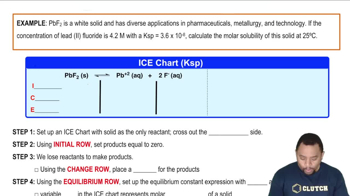Here are the essential concepts you must grasp in order to answer the question correctly.
Molar Solubility
Molar solubility refers to the maximum amount of a solute that can dissolve in a solvent at a given temperature, expressed in moles per liter (mol/L). It is a critical concept in understanding how ionic compounds dissociate in solution and is often determined from the solubility product constant (Ksp). For a compound MX, the molar solubility can be calculated by setting up an equilibrium expression based on its dissociation in water.
Recommended video:
Solubility Product Constant (Ksp)
The solubility product constant (Ksp) is an equilibrium constant that quantifies the solubility of a sparingly soluble ionic compound. It is defined as the product of the molar concentrations of the ions, each raised to the power of their coefficients in the balanced dissolution equation. For MX, Ksp = [M^+] [X^-], where [M^+] and [X^-] are the molar concentrations of the ions in solution, allowing for the calculation of molar solubility.
Recommended video:
Solubility Product Constant
Dissociation of Ionic Compounds
Dissociation of ionic compounds occurs when they dissolve in water, breaking apart into their constituent ions. For example, when MX dissolves, it separates into M^+ and X^- ions. This process is essential for calculating molar solubility, as the concentration of each ion at equilibrium directly influences the Ksp value. Understanding this dissociation helps in setting up the equilibrium expression needed to find the molar solubility from the given Ksp.
Recommended video:
 Verified step by step guidance
Verified step by step guidance

